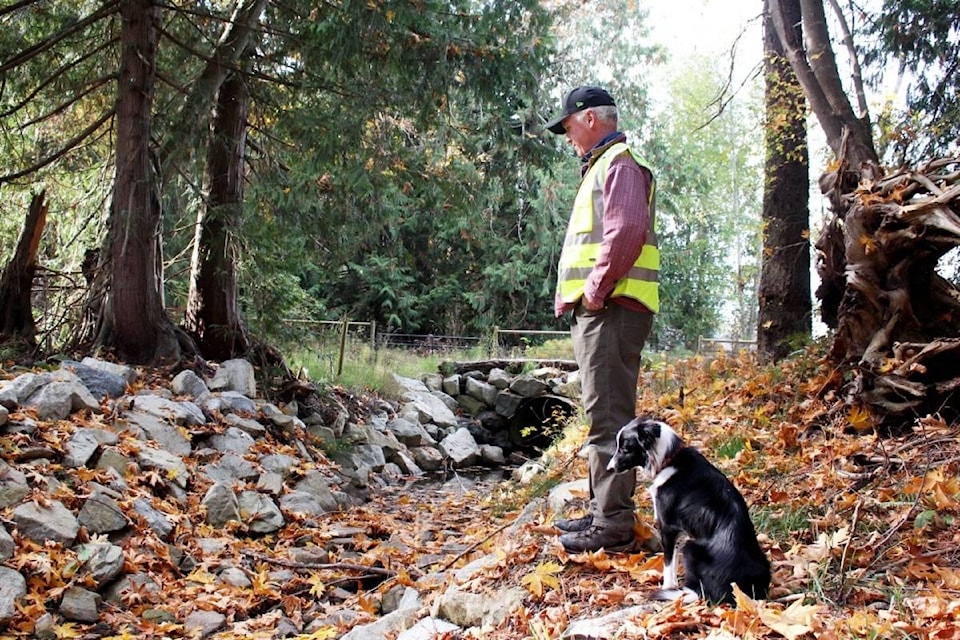Local stream stewards are hoping to educate people on water balance and sediment reduction for Shelly Creek.
The Mid Vancouver Island Habitat Enhancement Society (MVIHES) has spent recent years working to restore Shelly Creek, which runs through Parksville and Errington. Shelly Creek is a tributary of the Englishman River.
MVIHES, working in partnership with the City of Parksville, the Regional District of Nanaimo, Pacific Salmon Foundation and the Partnership for Water Sustainability in B.C. released an engineering study last month on how to restore watershed hydrology, prevent stream erosion and ensure fish survival.
To learn more about the report, visit www.mvihes.bc.ca/current-initiatives/the-imbalance-of-the-shelly-creek-watershed.
Peter Law, MVIHES vice president, said the local stream stewards began surveying the creek in 2010 and, in the first year, the sampling showed a high number of fish in the creek. He said at times there were upwards of 8,000 fish coming out of the stream.
However, in the first three years of monitoring the stream, Law said, the group noticed the site had some of the highest levels of sediment of any waterway in the regional district.
Law said MVIHES then decided to look into what was causing the sediment load that was making the stream wider and reducing the pools. He said the stream steward did a survey from Blower Road (just off Stanford Avenue) to Bellevue Road, looking at every metre of the stream to find the sediment source and to see if it was coming from one site, or many.
Law said the stream stewards did the same survey using the same method on almost the same stretch of water back in 1999.
What MVIHES found, Law said, was that the stream was putting more water through because of nearby developments.
He said the creek now has five times more water running through it than what was originally flowing through the creekbed.
Law said the stream is meant to have one litre per second, per hectare flowing through in its original, natural condition.
“The natural condition is no development,” Law said. “We’re not trying to get back to no development, we’re just trying to understand why the stream is the way it is.”
Because the stream is pushing so much water through, Law said, the trees and land around the stream are eroding.
In 2015, MVIHES conducted a project at the end of Blower Road to stop the erosion by placing large rocks on either side of the stream. However, that portion of the stream is filling up with sediment again.
“What’s happening is erosion from above (upstream) is starting to impact this site here,” Law said. “We’re happy that sediment from the (Blower Road) site is not creating sediment downstream, but there’s sediment coming from upstream.”
Now the society’s goal is to educate people in the watershed surrounding Shelly Creek. Law said the group will be conducting “kitchen table talks” to educate people on the effects of excess water running through the stream.
“We’ve got some issues around trying to slow the water down. As lands get developed, we ditch and we drain everything and that moves water into the channel faster and pushes it into this place,” Law said.
“As a site is developed or cleared, you’re actually looking at how you can slow the water down from that site, not drain it. You want to slow the water down, you want to put it back into that shallow groundwater to allow it to slowly work its way into this (creek) so Mother Nature can kind of take the water and not destroy the stream.”
Some of these options, Law said, could include rain gardens, planted depressions that allow rainwater runoff from urban areas to be absorbed.
Law said if people want to learn more about how they can balance rainwater on their properties they can visit https://waterbalance.ca/tool/water-balance-express/.
“We’re looking at those kinds of options. We realize that that will take a long time, but we have to educate.”
For story tips: lauren.collins@pqbnews.com
